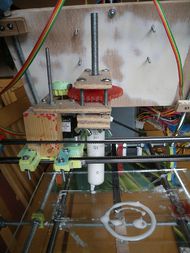David's Hotend (Bowden and Direct)
|
English • العربية • български • català • čeština • Deutsch • Ελληνικά • español • فارسی • français • hrvatski • magyar • italiano • română • 日本語 • 한국어 • lietuvių • Nederlands • norsk • polski • português • русский • Türkçe • українська • 中文(中国大陆) • 中文(台灣) • עברית • azərbaycanca • |
Mechanical: Overview | Mendel solid model files | Procurement | Preparation of materials | Assembly notes | Extruder | X-axis | Z-axis | Y-axis | Circuit boards | Frame | Squaring the axes
Release status: Experimental
| Description | Dual-purpose Bowden or Direct Drive Extruder Hot-End
|
| License | GPL
|
| Author | |
| Contributors | |
| Based-on | |
| Categories | |
| CAD Models | not available
|
| External Link |
A dual-purpose hot-end which can be used in either Bowden or direct drive extruder, using a Wades extruder to drive either mode.
Advantages:
Removable nozzle - so size can be varied in seconds Suitable for Bowden and Direct Drive setup without modification
Time: 3 hours (2 to make holder, 1 for nozzle)
Raw Materials:
Brass rod: 16mm diam (but if buying I'd get copper as better heat conductor) Brass rod: 6mm diam (ditto re copper) or M6 Grease Nipple (you'll have to braze the tip close then redrill to smalled diameter) Wire wound resistor Thermistor (100k) PEEK block (which I cut from a bit of rod) PTFE Tube (6.4mm OD x 3.2mm ID) Block of wood to make tip jig (I used 5x5cm, but pick anything similar scrap off the woodpile)
Tools used:
Drill press, Drill clamp Drill bits: 2.5mm, 3.2mm, 5mm, 6mm Tap: M6 (x3 to get good bottom tap) Bench mounted belt sander (not essential, but good for nicer finish) Dremel-type grinding disk (mounted in drill press)
Thermal Paste: In initial testing instead of fire cement, I used silicon grease mixed with some brass swarf from construction to improve heat conduction from resistor and to thermistor (it's teardrop shape means contact with the wall is poor, and I didn't want to cement things in during testing) My logic is: sand~firecement~silicon are all poor conductors (<1w/(m.K)) copper = 401 brass = 109 (steel = 43, iron = 80)
